 What is Theoretical Cosmology?
What is Theoretical Cosmology?

Theoretical
cosmologists study the evolution and composition of the universe
as a system, constructing theories and confronting them with experiments and
observations.
Many of the quantities of interest are
average properties; consequently,
theoretical cosmology deals to a large extent with statistical predictions
and measurements.
In recent years, advances in measurements and computational techniques have
brought us to the brink of quantifying precisely
these fundamental properties.
What is known?
There are some fundamental things about our universe which we do know with
high confidence:
- Our universe is
approximately homogeneous (the same at all points in space) and
isotropic (the same in all directions in space) on large scales and
at
early times.
- Our universe is
expanding (discovered by
Hubble in the 1920's).
- Space is flat on the average.
- The mass energy in the universe is approximately 1/4 matter and
3/4 "dark
energy", less than 1/5 of the matter is baryonic, the rest is "dark matter"
(see figure on right).
- The universe is approximately homogeneous and isotropic on large
scales or at early times.
- The distribution of matter in the universe today is statistically
consistent with growth from a close to scale invariant set of perturbations
at an early time under the influence of gravity.
|
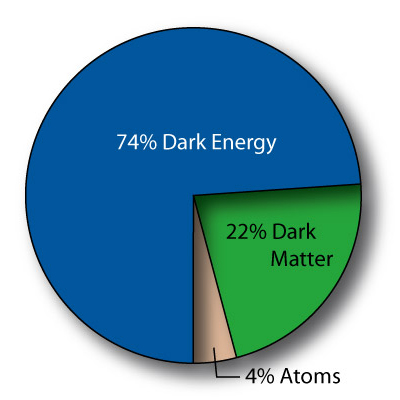 Picture from here
Picture from here
|
What is under study?
Specifics of this emerging paradigm are still under intense investigation.
These include:
- Exactly how fast is the universe
expanding? In other words, what
is the Hubble constant, H0?
- Exactly how much matter is there in the universe? What is it?
There is strong evidence for
dark matter
implied by, for example, the
motions
of astronomical objects. Is this matter some exotic particle from high
energy physics or a quantum black hole or something more prosaic?
What is this dark matter
made of?
- Is the dark energy a (cosmological
constant), i.e. an ambient 'vacuum' energy density in the universe?
Or is it not a cosmological constant but something varying?
How would particle theory produce this? And if it is not a constant,
how will it evolve (and thus
what is the ultimate fate of the universe - will it expand forever or
recollapse in a ``big crunch'')?
- Why was the universe approximately homogeneous and
isotropic at early times?
Did inflation
occur?
- How did departures from this purely homogeneous and isotropic universe
arise? What were the seeds for the
formation of structure
(stars, galaxies,
clusters of galaxies)?
These various questions fall into the areas of cosmological parameter
estimation (Hubble constant, matter density, dark energy density,
etc.), dark matter searches, early universe model building (inflationary
theory, theories of dark energy, string cosmology).
What are the new frontiers?
We now have an incomplete, but highly predictive, theory which connects the
structure we see in the universe today to the exotic high-energy physics of
the early universe. Within this paradigm calculations can be carried out with
high precision (often numerically)
and their predictions compared to the wealth of observational and
experimental data we are
rapidly accumulating. In particular,
with many of the parameters/properties
mentioned above approximately known, initial
conditions are now in place to ask other questions:
- Structure formation
What is the (statistical and precise)
distribution of structure today and how is
it evolving? On large scales, on small scales?
Are there simple ways to characterize and understand the
emergence of
regular structures and regularity
from the complexity due to gravitational collapse?
- Galaxy properties
Can we extend our understanding of what matter
is doing to an understanding of what luminous (more often
observed) matter is doing?
Dark matter halos
can be reliably simulated using numerical simulations of dark matter and
gravity only, and galaxies populate these halos often in a many to one
manner. How do they do so
and what galaxy properties determine the association to
the host dark matter halos (collapse time, recent merger activity)?
- Galaxy formation
How do galaxies form?
What is the role of black hole growth and quasar activity in
the history of galaxies? How do objects at high redshift evolve into
those we see today; what are the progenitors of today's galaxies of
different sorts, of
clusters? How did the history of galaxies affect their surroundings
(injecting metals, for instance)?
- Reionization
How and when did the first luminous objects form and how did
reionization occur? What is the respective role of stars and
quasars in producing ionizing photons? Were there early supermassive
stars (PopIII) and if so, when did they stop forming and what happened
at the end of their lifetimes?
Measurements addressing these questions also can shed light on
cosmological parameters, etc., and vice versa.
Different theories (e.g. different types of matter)
predict different results for each of the properties above, and different
cosmological histories.
Observational Input
The cosmological history and other properties can be measured in several ways.
For example,
-
 The
expansion of the universe can be studied by
measuring redshifts of cepheids, just as Hubble did in the
1920's. The cepheids fluctuate in luminosity on a time scale
related to their luminosity. Knowing their absolute
luminosity allows one to calculate their distance. The Hubble Space
Telescope has a
Key Project
to measure the Hubble Constant H0.
An introduction can be found in this
Scientific American article by W. Freedman.
Also, some recent review articles are at
this
link,
here and
here (a recent workshop summary).
(Hubble diagram taken
from
this paper.)
The
expansion of the universe can be studied by
measuring redshifts of cepheids, just as Hubble did in the
1920's. The cepheids fluctuate in luminosity on a time scale
related to their luminosity. Knowing their absolute
luminosity allows one to calculate their distance. The Hubble Space
Telescope has a
Key Project
to measure the Hubble Constant H0.
An introduction can be found in this
Scientific American article by W. Freedman.
Also, some recent review articles are at
this
link,
here and
here (a recent workshop summary).
(Hubble diagram taken
from
this paper.)
-
 Type I supernovae are well characterized and can be used
as another standard candle (object with 'known' absolute luminosity).
Again, if their absolute luminosity is
known, their distance from us can be deduced.
High redshift supernovae searches are being pursued by
the supernova cosmology project
and
the high-z supernova search (the latter is the source of the
figure at left). They can be used to measure the
energy density of the universe, and the cosmological constant.
(This picture is from
Goddard.)
Type I supernovae are well characterized and can be used
as another standard candle (object with 'known' absolute luminosity).
Again, if their absolute luminosity is
known, their distance from us can be deduced.
High redshift supernovae searches are being pursued by
the supernova cosmology project
and
the high-z supernova search (the latter is the source of the
figure at left). They can be used to measure the
energy density of the universe, and the cosmological constant.
(This picture is from
Goddard.)
-
 Large scale structure refers to the distribution of matter on
very large scales in the universe, around and above 10 Mpc. This can be
studied by
galaxy
surveys, looking at the
spectra of quasars as their light travels through hydrogen clouds to
reach us
(Lyman alpha systems)
and comparing with
simulations such as
these,
and
weak lensing,
quasar clustering and
peculiar velocity measurements.
The relation of the hydrogen clouds to other structures at different
redshifts is schematically
pictured
by Z. Haiman.
Large scale structure refers to the distribution of matter on
very large scales in the universe, around and above 10 Mpc. This can be
studied by
galaxy
surveys, looking at the
spectra of quasars as their light travels through hydrogen clouds to
reach us
(Lyman alpha systems)
and comparing with
simulations such as
these,
and
weak lensing,
quasar clustering and
peculiar velocity measurements.
The relation of the hydrogen clouds to other structures at different
redshifts is schematically
pictured
by Z. Haiman.
-
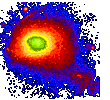 Clusters of galaxies are used to study the total matter energy
density of the universe by measuring their baryon content
(cluster baryon fraction)
and their abundance and evolution
(see this
review article
or
this
or this for
recent work).
They can be
used to measure the expansion rate H0.
via the
Sunyaev-Zeldovich effect
(a 1996 review
and a more recent
review).
Galaxy clusters can also be
gravitational lenses.
Clusters of galaxies are used to study the total matter energy
density of the universe by measuring their baryon content
(cluster baryon fraction)
and their abundance and evolution
(see this
review article
or
this
or this for
recent work).
They can be
used to measure the expansion rate H0.
via the
Sunyaev-Zeldovich effect
(a 1996 review
and a more recent
review).
Galaxy clusters can also be
gravitational lenses.
-
 Gravitational lensing: the statistics of number of lenses gives
limits on the cosmological constant (a classic reference is
here and
a data base of lenses is
here).
Time delays from gravitational lenses can be used to
measure H0, the Hubble constant
(see e.g. this
review article
or
this one).
There is a
wiki on measuring the Hubble constant via lensing.
Weak lensing as above can be used to study large scale structure.
The picture source is
here.
Gravitational lensing: the statistics of number of lenses gives
limits on the cosmological constant (a classic reference is
here and
a data base of lenses is
here).
Time delays from gravitational lenses can be used to
measure H0, the Hubble constant
(see e.g. this
review article
or
this one).
There is a
wiki on measuring the Hubble constant via lensing.
Weak lensing as above can be used to study large scale structure.
The picture source is
here.
-
 The
CMB
(Cosmic Microwave Background) is made up of photons coming to us from the
time when they decoupled from matter.
The photons have the imprint of what the charged matter was doing right before
decoupling, as well as the imprint of the gravitational potential they have
travelled through in the subsequent 10 billion plus years to reach us.
The very small size of the fluctuations in the CMB means that calculational
approximations are well controlled, and the resulting predictions are
consequently very accurate.
The LAMBDA site
maintains a list of current
and upcoming experiments and data.
Many review articles on the CMB at various levels can be found
here.
The
CMB
(Cosmic Microwave Background) is made up of photons coming to us from the
time when they decoupled from matter.
The photons have the imprint of what the charged matter was doing right before
decoupling, as well as the imprint of the gravitational potential they have
travelled through in the subsequent 10 billion plus years to reach us.
The very small size of the fluctuations in the CMB means that calculational
approximations are well controlled, and the resulting predictions are
consequently very accurate.
The LAMBDA site
maintains a list of current
and upcoming experiments and data.
Many review articles on the CMB at various levels can be found
here.
-
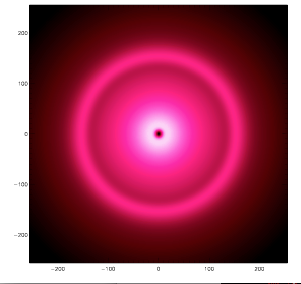 Baryon acoustic oscillations (BAO), from the same fluctuations sourcing the
CMB, also leave traces in the power spectrum (clustering) of objects,
e.g. galaxies, at later times, and can be used to probe both the Hubble
parameter and the angular scale at a given redshift,
giving clues to any evolution of dark energy (if any evolution occurs).
In low redshift galaxy data (SDSS and 2DF) a small BAO signal is expected and
seems present, many other
galaxy surveys are underway or planned as are searches for the
signal in other phenomena besides galaxies.
A BAO resource list is
here.
(See also
Daniel Eisenstein's
page.)
Baryon acoustic oscillations (BAO), from the same fluctuations sourcing the
CMB, also leave traces in the power spectrum (clustering) of objects,
e.g. galaxies, at later times, and can be used to probe both the Hubble
parameter and the angular scale at a given redshift,
giving clues to any evolution of dark energy (if any evolution occurs).
In low redshift galaxy data (SDSS and 2DF) a small BAO signal is expected and
seems present, many other
galaxy surveys are underway or planned as are searches for the
signal in other phenomena besides galaxies.
A BAO resource list is
here.
(See also
Daniel Eisenstein's
page.)
- ETC! These are just some examples, many other
useful methods exist and more are being invented all the time.
list compiled by M. White and J. Cohn
Last modified March 17, 2006.
jcohn@astron.berkeley.edu
This page was developed in collaboration with
Martin White.
|
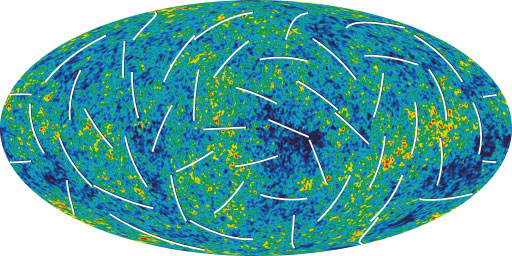 Picture from here
Picture from here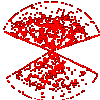




 Picture from here
Picture from here



